[ Presentation | Installation | Usage | Share a database with another machine | Change movie genres | kodi and homecinema | Youtube extension ]
Media center kodi
This site has been automatically translated with Google Translate from this original page written in french, there may be some translation errors
Presentation
Facility
First we will install the following packages by typing the command below:urpmi swig lib64ass-devel lib64modplug-devel lib64yajl2 lib64tinyxml0 lib64pcrecpp-devel lib64jasper-devel gperf lib64expat-devel gnutls lib64tinyxml-devel gnutls-devel lib64lzo-devel lib64microhttpd-devel lib64uuid-devel lib64avahi-client-devel lib64mariadb-devel python-mako lib64drm-devel llvm-devel python3-devel rapidjson lib64cdio-devel pulseaudio-devel lib64xslt-devel lib64vdpau-devel curl-devel lib64sqlite3-devel taglib-devel lib64freeglut-devel lib64xrandr-devel java lib64spdlog-devel lib64waylandpp-devel lib64gif-devel doxygen lib64dav1d-devellib64flatbuffers-devel lib64mesaegl-devel lib64mesaglesv2-devel lib64gbm-devel dcadec-devel lib64crossguid-devel lib64fstrcmp-devel lib64tinyxml2-devel wayland-protocols-devel edid-decode
for those who have an intel GPU we will also install lib64vdpau-va-gl1 lib64va-devel
We will then install libdisplayinfo which we will find here https://gitlab.freedesktop.org/emersion/libdisplay-info we unzip the archive by typing
tar xvfj
libdisplay-info-0.2.0.tar.bz2
this gives the directory libdisplay-info-0.2.0 in which we type
meson setup build
ninja -C build
then as root
cd build
meson install
ln -s
/usr/local/linux/multimedia/libdisplay-info-0.2.0/include/libdisplay-info/
/usr/local/include
we finally get the sources of the latest version 21.2 Omega here https://github.com/xbmc/xbmc/releases we unzip it by typing
tar xvfz xbmc-21.2-Omega.tar.gzthis gives the xbmc-21.2-Omega
directory in which we
type
mkdir build cd build
cmake -DENABLE_BLUETOOTH=OFF -DENABLE_INTERNAL_FFMPEG=ON
-DENABLE_SMBCLIENT=OFF -DENABLE_UPNP=OFF -DENABLE_BLURAY=OFF
-DENABLE_LCMS2=OFF -DENABLE_LIRCCLIENT=OFF
-DMYSQLCLIENT_INCLUDE_DIR=/usr/include/mysql/
-DENABLE_NFS=OFF -DENABLE_SNDIO=OFF -DENABLE_CEC=OFF
-DENABLE_CCACHE=OFF -DENABLE_CAP=OFF -DAPP_RENDER_SYSTEM=gles
-DENABLE_MARIADBCLIENT=OFF -DENABLE_CLANGFORMAT=OFF
-DLIBDISPLAYINFO_INCLUDE_DIR=/usr/local/linux/multimedia/libdisplay-info-0.2.0
..
-- Platforms: x11 wayland gbm
-- App package: org.xbmc.kodi
-- -- PATH config --
-- Prefix: /usr/local
-- Libdir: /usr/local/lib64
-- Bindir: /usr/local/bin
-- Includedir: /usr/local/include
-- Datarootdir: /usr/local/share
-- Datadir: /usr/local/share
-- Docdir: /usr/local/share/doc/kodi
-- CCACHE enabled: No
-- CLANGFORMAT enabled: No
-- CLANGTIDY enabled: No
-- CPPCHECK enabled: No
-- INCLUDEWHATYOUUSE enabled: No
-- ALSA enabled: Yes
-- AVAHI enabled: Yes
-- BLUETOOTH enabled: No
-- BLURAY enabled: No
-- CAP enabled: No
-- CEC enabled: No
-- DAV1D enabled: Yes
-- DBUS enabled: Yes
-- ISO9660PP enabled: Yes
-- LCMS2 enabled: No
-- LIRCCLIENT enabled: No
-- MDNS enabled: No
-- MICROHTTPD enabled: Yes
-- NFS enabled: No
-- PIPEWIRE enabled: No
-- PLIST enabled: No
-- PULSEAUDIO enabled: Yes
-- PYTHON enabled: Yes
-- SMBCLIENT enabled: No
-- SNDIO enabled: No
-- UDEV enabled: Yes
-- UDFREAD enabled: No
-- XSLT enabled: Yes
-- VAAPI enabled: Yes
-- VAAPI enabled: Yes
-- VAAPI enabled: Yes
-- MARIADBCLIENT enabled: No
-- MYSQLCLIENT enabled: Yes
-- Configuring done (21.5s)
-- Generating done (2.0s)
-- Build files have been written to: /usr/local/linux/multimedia/xbmc-21.2-Omega/build
cd ..
make -j5 -C
tools/depends/target/binary-addons PREFIX=/usr/local
make -j5 -C tools/depends/target/binary-addons PREFIX=/usr/local ADDONS="game.*"
and we will make sure to delete the traces of an old installation ( /usr/local/share/xbmc or /usr/local/lib/xbmc )
Use

Movies are categorized by genre, year or actors, movies that have been the subject of several versions are in the "sagas" category. I prefer to skip the genre to select my movie
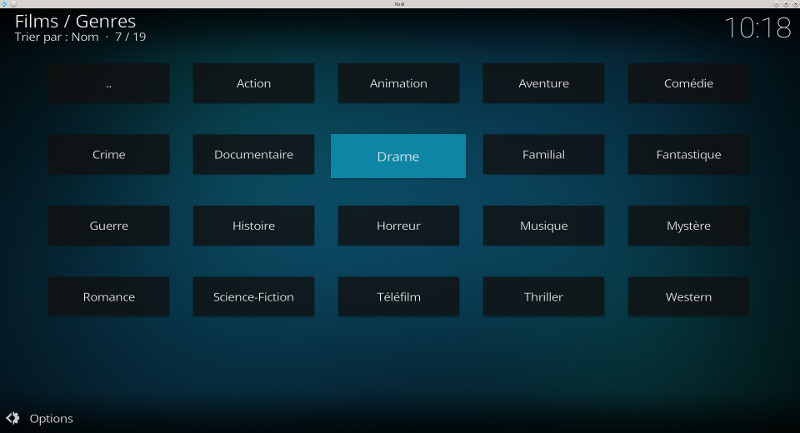
When you select a film, you have the summary and a whole bunch of information, you can of course view it afterwards.
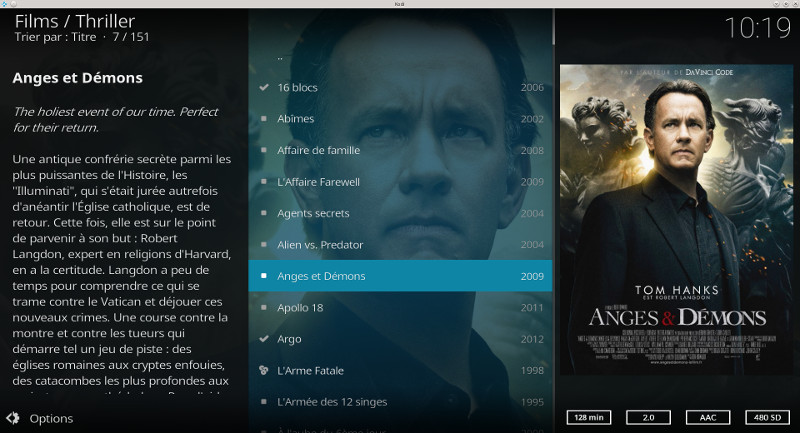
The same goes for music, this requires that your music files are correctly tagged, please go see here how to do this automatically with MusicBrainz Picard .
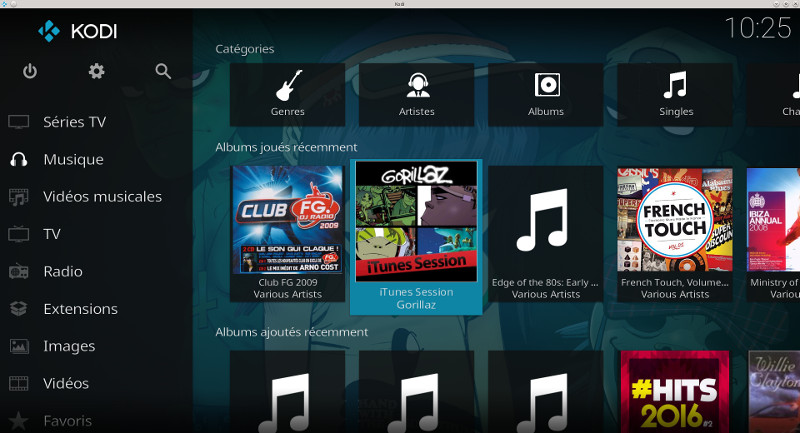
In artist search mode
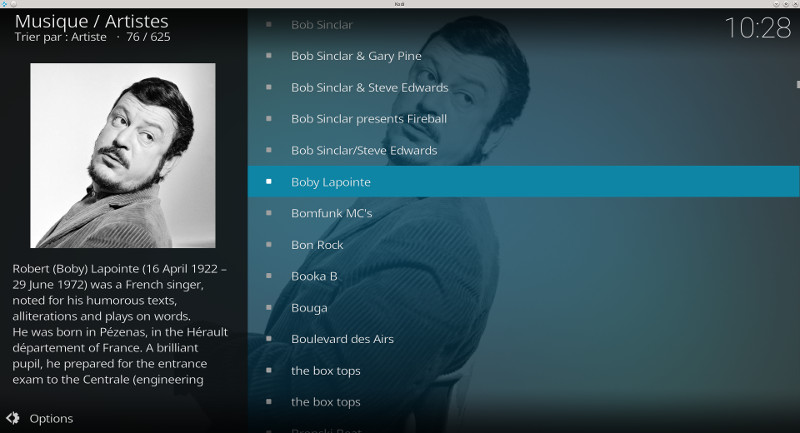
In music playback mode, there is of course a way to create your own playlists.
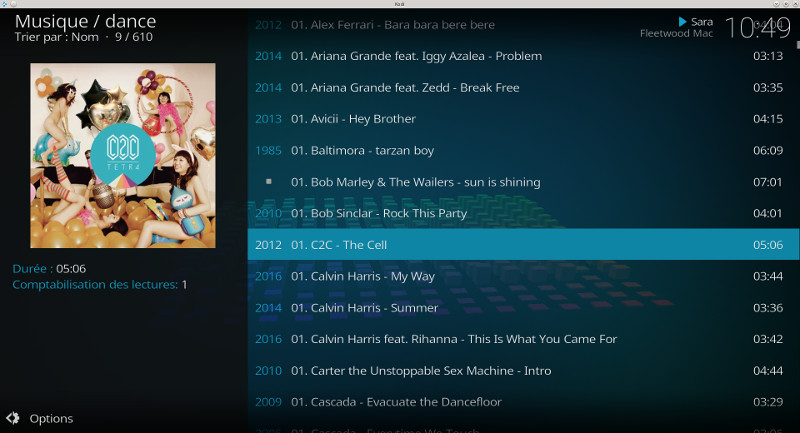
Kodi also allows you to watch TV online (via the Internet or a box), listen to online radio or view your photos. There are a lot of sites that present Kodi, Media Passion with its forum and wiki is a very good entry point.
Share a database with another machine
Now to make your database accessible to everyone on your network regardless of the machine used, we will install it on a MySQL server. On this server we will create a kodi user by typing
mysql -u root -phere is the result
Enter password:
Welcome to the MySQL monitor. Commands end with ; or \g.
Your MySQL connection id is 25
Server version: 5.6.27 Source distribution
Copyright (c) 2000, 2015, Oracle and/or its affiliates. All rights reserved.
Oracle is a registered trademark of Oracle Corporation and/or its
affiliates. Other names may be trademarks of their respective
owners.
Type 'help;' or '\h' for help. Type '\c' to clear the current input statement.
mysql> CREATE USER 'kodi' IDENTIFIED BY 'kodi';
Query OK, 0 rows affected (0.00 sec)
mysql> GRANT ALL ON *.* TO 'kodi';
Query OK, 0 rows affected (0.00 sec)
mysql> flush privileges;
Query OK, 0 rows affected (0.00 sec)
Now under kodi with your main user we will export the database from the menu System-> Video Media Library-> Export video media library
To the question Export to a single file or separate files for each element , we answer SeparateTo the question Export thumbnails and fanarts , we answer Yes
To the question Export actor thumbnails , we answer Yes
To the question Overwrite old files , we answer Yes
This will create as many .nfo files as there are movies, each .nfo file is in the same directory as the movie it is supposed to describe. This is what it looks like
<?xml version="1.0" encoding="UTF-8"
standalone="yes" ?>
<movie>
<title>Molière</title>
<originaltitle>Molière</originaltitle>
<rating>6.900000</rating>
<epbookmark>0.000000</epbookmark>
<year>2007</year>
<top250>0</top250>
<votes>14</votes>
<outline></outline>
<plot>In 1644, Molière was only twenty-two years old.
Riddled with debt and pursued by bailiffs, he persisted in
putting on
tragedies in which he was
undeniably bad. And then one day, after being imprisoned by
impatient creditors, he disappears
...</plot>
<tagline></tagline>
<runtime>121</runtime>
<thumb aspect="poster"
preview="http://image.tmdb.org/t/p/w500/hug2HMnzkW2fsvAPyYuBt0Ssg9A.jpg">http://image.tmdb.org/t/p/original/hug2HMnzkW2fs
vAPyYuBt0Ssg9A.jpg</thumb>
<thumb aspect="poster"
preview="http://image.tmdb.org/t/p/w500/9eTXAm7a7jY8tkGRgGtnyUUzKHw.jpg">http://image.tmdb.org/t/p/original/9eTXAm7a7jY8t
kGRgGtnyUUzKHw.jpg</thumb>
<fanart>
<thumb
preview="http://image.tmdb.org/t/p/w780/nFdQrZM2upgnRsxVHvDzBHh5M8w.jpg">http://image.tmdb.org/t/p/original/nFdQrZM2upgnRsxVHvDzBHh5M
8w.jpg</thumb>
<thumb
preview="http://image.tmdb.org/t/p/w780/xBdllc2nxZBZ1olZA2aWLuuB7eW.jpg">http://image.tmdb.org/t/p/original/xBdllc2nxZBZ1olZA2aWLuuB7
eW.jpg</thumb>
<thumb
preview="http://image.tmdb.org/t/p/w780/wRaODxHVpPUgHWg7iXRCia35sNQ.jpg">http://image.tmdb.org/t/p/original/wRaODxHVpPUgHWg7iXRCia35s
NQ.jpg</thumb>
</fanart>
<mpaa>Rated</mpaa>
<playcount>0</playcount>
<lastplayed></lastplayed>
<id>tt0796335</id>
<genre>Drama</genre>
<genre>Comedy</genre>
<genre>Romance</genre>
<genre>Foreign</genre>
<country>France</country>
<set></set>
<director>Laurent Tirard</director>
<premiered></premiered>
<status></status>
<code></code>
<aired></aired>
<trailer>plugin://plugin.video.youtube/?action=play_video&videoid=NySWrKfEa4E</trailer>
<fileinfo>
<streamdetails>
<video>
<codec>xvid</codec>
<aspect>2.352941</aspect>
<width>640</width>
<height>272</height>
<durationinseconds>7260</durationinseconds>
<stereomode></stereomode>
</video>
<audio>
<codec>mp3</codec>
<language></language>
<channels>2</channels>
</audio>
</streamdetails>
</fileinfo>
<actor>
<name>Romain Duris</name>
<role>Moliere</role>
<order>0</order>
<thumb>http://image.tmdb.org/t/p/original/buU0mFOX7PvSr50F6H8SrN71W08.jpg</thumb>
</actor>
<actor>
<name>Fabrice Luchini</name>
<role>Mr.
Jourdain</role>
<order>1</order>
<thumb>http://image.tmdb.org/t/p/original/wtdwJeLGUBkXSm0ElDlsGTDZcJD.jpg</thumb>
</actor>
<actor>
<name>Édouard Baer</name>
<role>Dorante</role>
<order>2</order>
<thumb>http://image.tmdb.org/t/p/original/bevNDP9RQU1b8UdZPElEw4f9fc9.jpg</thumb>
</actor>
<actor>
<name>Ludivine Sagnier</name>
<role>Celimene</role>
<order>3</order>
<thumb>http://image.tmdb.org/t/p/original/sc0yD6DWgYsMKBpKrYqaZDYz8SX.jpg</thumb>
</actor>
<resume>
<position>0.000000</position>
<total>0.000000</total>
</resume>
<dateadded>2010-09-03 10:28:57</dateadded>
</movie>
<advancedsettings>
<videodatabase>
<type>mysql</type>
<host>192.168.13.11</host>
<port>3306</port>
<user>kodi</user>
<pass>kodi</pass>
</videodatabase>
<videolibrary>
<importwatchedstate>true</importwatchedstate>
<importresumepoint>true</importresumepoint>
</videolibrary>
<musicdatabase>
<type>mysql</type>
<host>192.168.13.11</host>
<port>3306</port>
<user>kodi</user>
<pass>kodi</pass>
</musicdatabase>
</advancedsettings>
you will need
to indicate the IP address of the MySQL server. After restarting,
in the .kodi/temp/kodi.log file, we see the steps of the first creation of
the tables in debug mode, here is an extract
16:09:20
T:139806471604160 DEBUG: Mysql execute: CREATE INDEX
ixMusicVideoBasePath ON musicvideo ( c14(12) )
16:09:20
T:139806471604160 DEBUG: Mysql execute: CREATE INDEX
ixEpisodeBasePath ON episode ( c19(12) )
16:09:20
T:139806471604160 DEBUG: Mysql execute: CREATE INDEX
ix_streamdetails ON streamdetails (idFile)
16:09:20
T:139806471604160 DEBUG: Mysql execute: CREATE INDEX
ix_seasons ON seasons (idShow, season)
16:09:20
T:139806471604160 DEBUG: Mysql execute: CREATE INDEX ix_art
ON art(media_id, media_type(20), type(20))
16:09:20
T:139806471604160 DEBUG: Mysql execute: CREATE UNIQUE INDEX
ix_tag_1 ON tag (name(255))
16:09:20
T:139806471604160 DEBUG: Mysql execute: CREATE UNIQUE INDEX
ix_tag_link_1 ON tag_link (tag_id, media_type(20), media_id)
16:09:20
T:139806471604160 DEBUG: Mysql execute: CREATE UNIQUE INDEX
ix_tag_link_2 ON tag_link (media_id, media_type(20), tag_id)
16:09:20
T:139806471604160 DEBUG: Mysql execute: CREATE INDEX
ix_tag_link_3 ON tag_link (media_type(20))
16:09:20
T:139806471604160 DEBUG: Mysql execute: CREATE UNIQUE INDEX
ix_actor_1 ON actor (name(255))
in phpMyAdmin , I see that the databases MyVideo131 and MyMusic83 have been created. Now for another kodi user, you
will need to retrieve this advancedsettings.xml file and place it
under its .kodi/userdata directory .
Now to populate the MySQL database, you need to launch Kodi with your main user and update the media library, it will launch a scan as when initializing a new database except that it will read the .nfo files instead of starting from scratch. If that doesn't work, you need to edit the source containing the movies and with the context menu choose Search for new content . This is the kind of thing you can discover by viewing the .kodi/temp/kodi.log file
17:18:30 T:140142598506240 DEBUG: Mysql execute:
insert into actor (actor_id, name, art_urls) values(NULL,
'Dharmadasa Kuruppu', '')
17:18:30
T:140142598506240 DEBUG: Mysql execute: INSERT INTO
actor_link (actor_id, media_id, media_type, role,
cast_order) VALUES(3524,198,'movie','Chieftain',16)
17:18:30
T:140142598506240 DEBUG: Mysql execute: insert into actor
(actor_id, name, art_urls) values(NULL, 'Stany De Silva',
'')
17:18:30
T:140142598506240 DEBUG: Mysql execute: INSERT INTO
actor_link (actor_id, media_id, media_type, role,
cast_order) VALUES(3525,198,'movie','Sajnu',17)
17:18:30
T:140142598506240 DEBUG: Mysql execute: insert into actor
(actor_id, name, art_urls) values(NULL, 'Ruby de Mel', '')
17:18:31
T:140142598506240 DEBUG: Mysql execute: INSERT INTO
actor_link (actor_id, media_id, media_type, role,
cast_order) VALUES(3526,198,'movie','Village Woman',18)
17:18:31
T:140142598506240 DEBUG: Mysql execute: insert into actor
(actor_id, name, art_urls) values(NULL, 'Denavaka Hamine',
'')
We will do the same for the audio library. Now to use this database on other machines with other users, just copy the advancedsettings.xml file to the userdata directory of the other user on another machine. We will also need to copy the Textures13.db file under userdata/Database and the entire userdata/Thumbnails directory.
That's not all, if your files from your initial PC are on the /germaine/video/Films disk, on the other client workstations this directory must be shared by NFS mounting to the other workstations and must be configured as is as a source on these same workstations.
And there, without having to create a media library, reload or scan anything, you can find your database.
Change movie genres
Usage with database
There was a time when there was WiMM which allowed you to modify directly in the Kodi database, you can still find it here https://github.com/slash2009/XWMM which gave something like this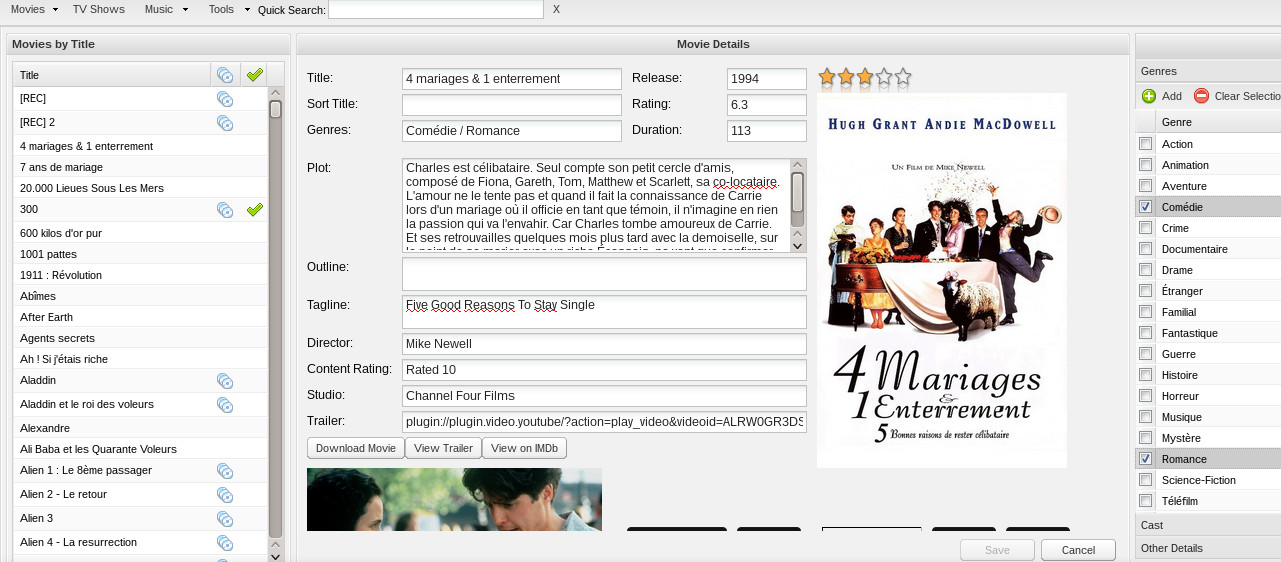
it is unfortunately no longer maintained and is no longer compatible with the latest versions of kodi . I have not found any other solutions than to do it with phpMyAdmin.
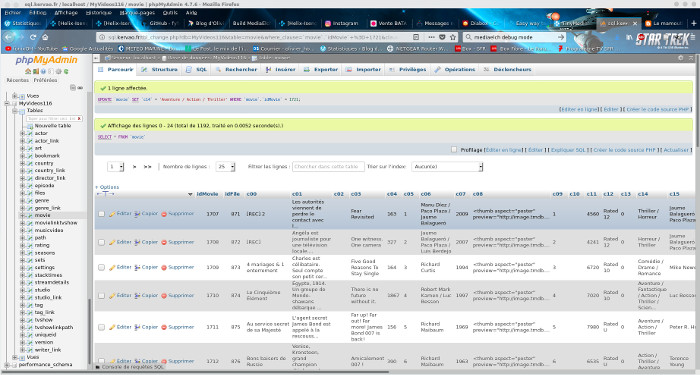
In fact, you have to choose the Kodi movie database, then the movie table and Search , in the c14 field which corresponds to the genre, you put %Fantasy% (without quotes) to select the movies in the Fantasy category, then if a movie is not classified correctly, you have to edit it and change the genre. I readily admit that this is a rather unfriendly method compared to what WiMM could provide.
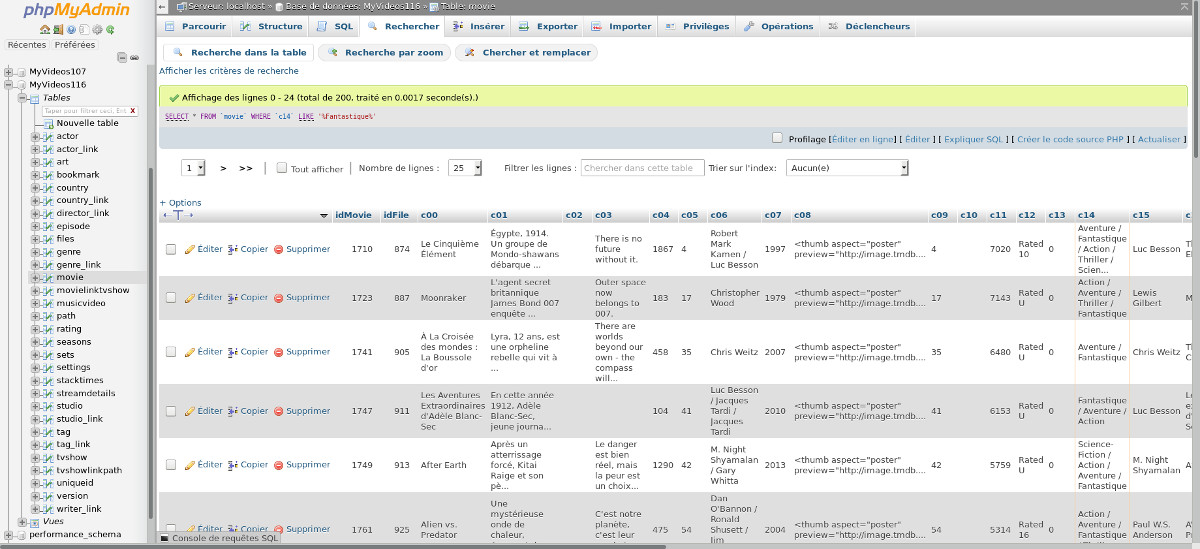
Usage with .nfo files
kodi does not use a database and relies on .nfo files in your movie directory. We can use MediaElch which can be found here https://github.com/Komet/MediaElch/releases first we will install the following packages lib64mediainfo-devel lib64qt6multimediawidgets-devel lib64qt6sql-devel lib64qt6help-devel and lib64quazip1-qt6-develwe unarchive the MediaElch archive by typing
MediaElch-2.12.0.tar.gz
this gives the directory MediaElch-2.12.0 in which we type
mkdir build
cd build
cmake .. -DUSE_EXTERN_QUAZIP=ON -DMEDIAELCH_FORCE_QT6=ON
make
make install
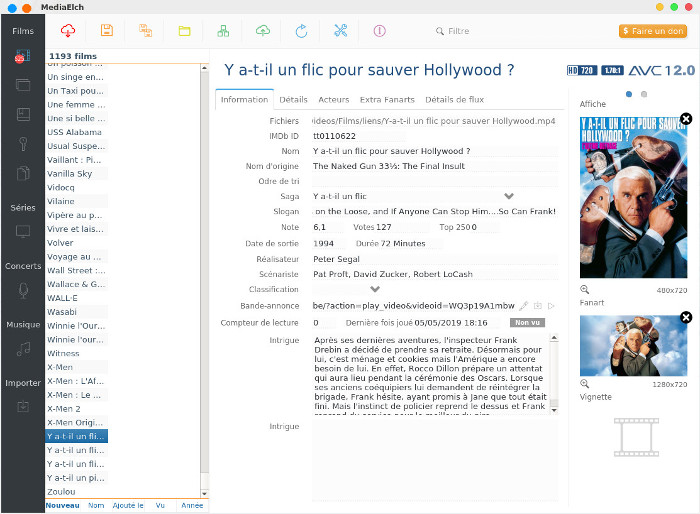
you can select movies of a certain genre

and if a movie is not in the right category, we modify it and MediaElch will modify the .nfo file
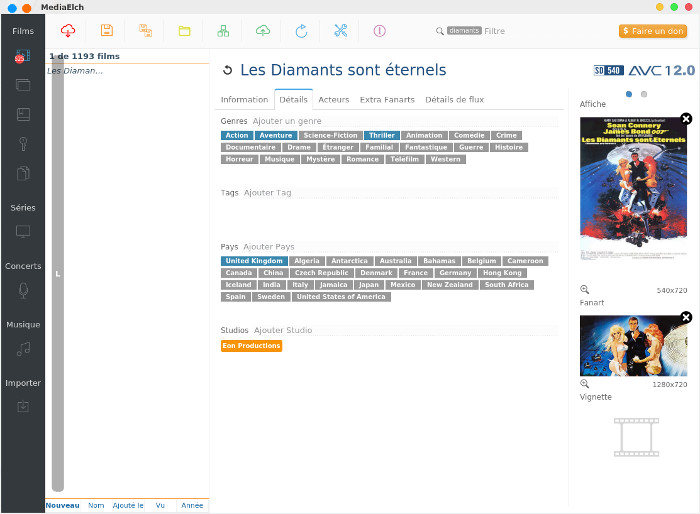
MediaElch can do much more, it can act on all the other information of each movie.
Kodi and home cinema
You have a sound bar and/or a multichannel audio home cinema system, it is possible to configure kodi to be able to enjoy it. In fact it is not really plug and play and there are some manipulations to be done on the PC to take into account these audio technologies. It starts with the configuration of PulseAudio , we launch its configuration utility and in the Configuration tab we must point to the HDMI output (since the PC is connected first to the bar, then the bar to the TV), we must not choose the multichannel HDMI outputs 5.1 or 7.1 even if the bar allows it.
Then in the Output Devices tab in the advanced options, I check all the boxes related to the different audio technologies available.
Now under kodi, in the Audio system settings in expert mode, I choose the Audio output device corresponding to the HDMI output, for Output configuration, I put Best match, I check Stereo to multichannel mix (even if I have a doubt that it should be done, to be tested).
Then further down, I check Enable Passthrough mode ( Audio Passthrough ) and all the boxes below.
And there, the difference is even more obvious if we activate Dolby Atmos mode on the sound bar.
Now regarding the audio format of movies, we basically have two choices, the AAC codec and the AC3 (Dolby digital) codec. The first one is a very good choice for sound quality, while the second one was designed for surround sound even though it is known to provide lower quality sound than AAC.
To go further, a little reading, first of all Understanding the different formats of cinema sound, and Obtaining multichannel sound from your computer under Linux.
Youtube extensions
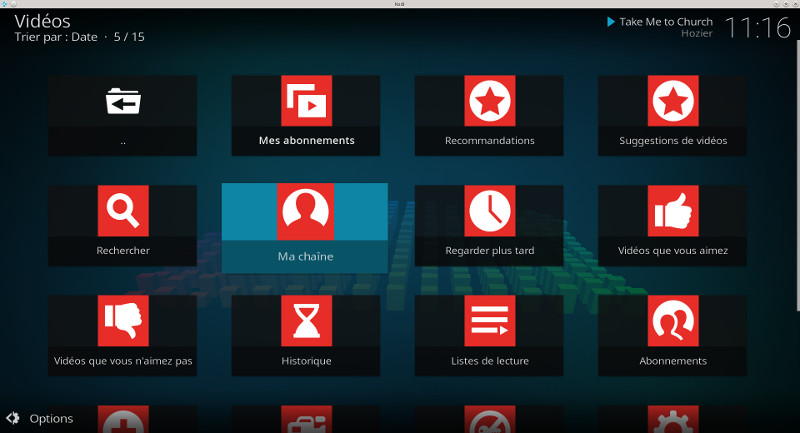
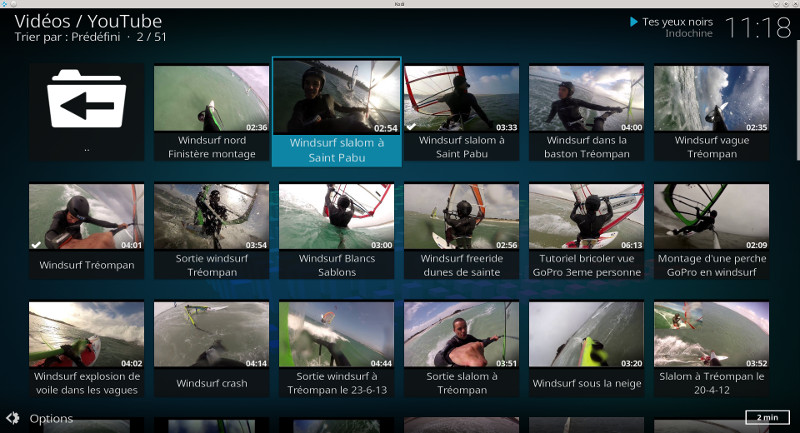
| [ Back to home ] | [ Back to top of page ] |
 Welcome
Welcome Linux
Linux Unix
Unix Download
Download



